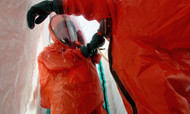3 Tips When Picking the Correct Chemical Safety Suit
Posted by William Kimmell on 14th Sep 2023
Chemical safety suits, also called hazmat suits, are full-body safety clothing and gear. Specific suits and components protect workers from chemical spills, pathogens, and toxic fumes.
Chemical suits are the last line of defense against chemical and biological hazards, so getting the proper equipment is crucial. Use these three tips for picking the correct chemical safety suit.
Assess Chemical Hazards and Personal Exposure Risk
Conduct a chemical hazard assessment to understand your worksite’s unique environment. Consult all safety data sheets (SDSs) the chemical manufacturer provides.
Each chemical’s SDS will provide the following details:
- Hazard identification—health and environmental
- PPE requirements
- First aid treatments
- Spill cleanup procedures
Make a list of the chemicals workers interact with and determine their personal exposure. Use the corresponding SDSs to understand protection requirements.
Consider the Suit’s Rated Protection Level
Another tip for picking the correct chemical safety suit is to consider the suit’s rated protection level. The US categorizes hazmat suits into four distinct classes based on the degree of safety they provide from specific dangers.
Level A: Maximum Protection
Level A suits offer the highest respiratory, skin, eye, and mucous membrane protection. The typical Level A ensemble includes a self-contained breathing apparatus (SCBA), a fully encapsulating chemical suit, gloves, and boots.
Level B: Protection From Liquid Splashes With SCBA
Level B suits have enhanced respiratory protection because of the SCBA but offer less skin and eye protection than Level A suits. Level B suits include SCBA, chemical-resistant clothing, gloves, and boots.
Level C: Protection From Liquid Splashes With APR
Level C suits provide limited protection and guard against specific hazards that don’t require full encapsulation. Before using a Level C suit, know the identity of the airborne substance and measure its concentration. These suits include a full- or half-mask air-purifying respirator (APR), chemical-resistant clothing, chemical-resistant gloves, and safety boots.
Level D: Basic Protection
Level D suits offer the most minimal protection. This level is only an option when the atmosphere has no known hazards and there is no risk for splashes, inhalation, immersion, or direct contact with the chemical threat.
Level D does not require respiratory protection. Level D protection includes safety footwear, safety glasses, and coveralls.
Check the Suit’s Certification
Finally, always check the suit’s certification to understand how it meets the required standards. North America’s highest level of accreditation comes from the National Fire Protection Association (NFPA).
The NFPA 1991 certification sets standards for the following factors:
- Chemical permeation
- Flame resistance
- Material durability
- Vapor tightness
The NFPA 1991 specifies the minimum design and performance requirements for clothing and ensembles that protect personnel from chemical, biological, radiological, and nuclear hazards. Consider NFPA 1991 certification when choosing protective clothing and gear.
Protect your workers by consulting SDS forms, choosing suits in the appropriate safety level category, and checking each suit’s certification. TG Technical Services provides NFPA 1991-certified chemical-resistant suits, including Level A and Level B ensembles. Shop with us today for reliable protective garments.

